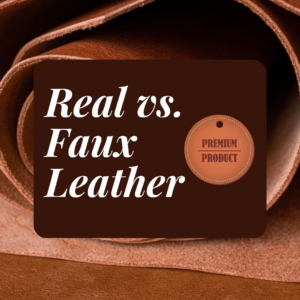March 3rd, 2023
Leather has made its way into mainstream fashion once again. According to WhoWhatWear, “Leather jackets are the go-to outerwear staple of the fashion crowd in 2023” (Mayhew), and Doc Martens have resurfaced to hold their place as a staple boot since 2019. But before adding any new leather apparel to your wardrobe, it’s good to know some key information about the leather that you’re buying, whether it be faux or real.
If your main priority for your clothing is its durability and lifespan, real leather trumps faux leather by far. Faux leather’s laminated surface can crack after a few years of wear, while authentic leather has potential to last a few decades before cracking (Garrett Leather). Real leather is a clothing investment strong enough to last multiple trend cycles, and durable enough to be worn for more than a fashion piece!
Unfortunately, neither material is good for the atmosphere. At a glance, real leather seems to produce more Co2 emissions than faux leather, being mainly emitted from livestock, but when taking into consideration how leather is not the only thing being produced by these animals, 100% of the animal emissions can’t be attributed to leather production. Faux leather also contributes to Co2 in the atmosphere from fossil fuels, and emits microplastics into the atmosphere, so neither option can assuredly be called better for the planet. Only when the leather is bought secondhand does it avoid heavily polluting the air and contributing to climate change, although it’s important to note faux leather rarely lasts long enough to be passed down to a second owner.
One of the main reasons faux leather exists is because it’s a vegan, cruelty-free leather, something real leather can never be. While real leather production is almost always made from the skin of animals already being killed for meat production, that doesn’t change the fact that the leather is coming from the death of an animal. Many consumers find that to be enough reason to never buy new, real leather (there is some debate around the ethics of second-hand leather among the vegan community).
In the end it’s up to you to decide what leather fits what you need, whether you’re just participating in a fashion trend, or looking for a durable pair of boots to last for years. Staying educated about the materials you’re buying can help make more conscious, intentional decisions while shopping to benefit you and the world.
By : Taylor Murphy
Categories: Fashion

